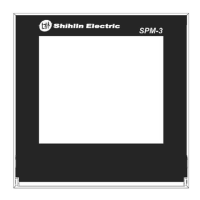Data
(Hi)
Data
(Lo)
Error
Check
(Lo)
Error
Check
(Hi)
Response:
Slave
Address
Function
Code
0x10
Start
Address
(Hi)
Start
Address
(Lo)
Number
of Points
(Hi)
Number
of Points
(Lo)
Error
Check
(Lo)
Error
Check
(Hi)
5.4 IEEE 754 Format
The bits in an IEEE 754 format have the following significance:
Data Hi Word,
Hi Byte
Data Hi Word,
Lo Byte
Data Lo Word,
Hi Byte
Data Lo Word,
Lo Byte
SEEE EEEE EMMM MMMM MMMM MMMM MMMM MMMM
Where:
S represents the sign bit where 1 is negative and 0 is positive
E is the two’s complement exponent with an offset of 127, i.e. an exponent of zero is represented
by 127, an exponent of 1 by 128 etc.
M is the 23-bit normal mantissa. The highest bit is always 1 and, therefore, is not stored.
For each floating point value requested two Modbus registers or points (four bytes) must be
requested. The received order and significance of these four bytes for the Integral products is shown
below:
Data Lo Word,
Hi Byte
Data Lo Word,
Lo Byte
Data Hi Word,
Hi Byte
Data Hi Word,
Lo Byte
5.5 Modbus RTU Mode
Since Controllers can be setup to communicate on standard Modbus networks using either of two
transmission modes:ASCII or RTU. SPM-3 uses RTU transmission mode only. Users select the RTU
mode, along with the serial port communication parameters( baud rate, parity mode, etc ), during
configuration of each controller. The mode and serial parameters must be the same for all devices on a
Modbus connection.
RTU Mode
Coding System 8-bit binary, hexadecimal 0-9, A-F
Two hexadecimal character contained in each 8-bit field of
the message
Bits per Byte 1 start bit
8 data bits, least significant bit sent first
none parity
1/2 stop bit
Error Check Field Cyclical Redundancy Check(CRC)

